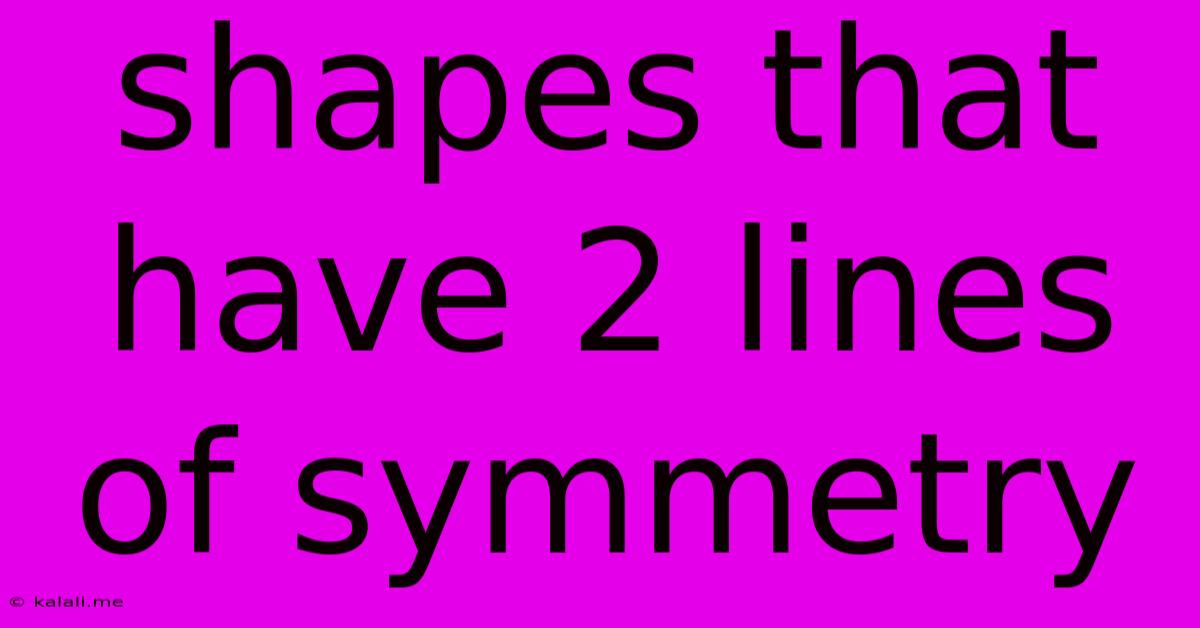Shapes That Have 2 Lines Of Symmetry
Kalali
Jun 16, 2025 · 3 min read

Table of Contents
Shapes with Two Lines of Symmetry: A Comprehensive Guide
This article explores two-dimensional shapes possessing exactly two lines of symmetry. Understanding lines of symmetry is crucial in geometry and helps us analyze the visual balance and properties of various shapes. We'll examine common shapes and delve into the characteristics that define their symmetrical nature. Learn to identify these shapes and grasp the concept of symmetry more effectively.
What is a Line of Symmetry?
Before we dive into shapes with two lines of symmetry, let's define what a line of symmetry is. A line of symmetry divides a shape into two identical halves that are mirror images of each other. If you fold the shape along the line of symmetry, both halves perfectly overlap.
Shapes with Only Two Lines of Symmetry
Several shapes boast precisely two lines of symmetry. Let's explore some key examples:
1. Isosceles Trapezoid (with specific conditions):
An isosceles trapezoid has two equal sides (legs) and two parallel sides (bases). However, not all isosceles trapezoids have two lines of symmetry. Only those with congruent base angles will have exactly two lines of symmetry: one vertical line running through the midpoints of the bases and another horizontal line.
2. Kite:
A kite is a quadrilateral with two pairs of adjacent sides that are equal in length. Its lines of symmetry are the perpendicular bisectors of the diagonals, hence, it usually has exactly two lines of symmetry. One line passes through the two equal angles, and the other bisects the unequal angles, creating two mirror-image halves.
3. Rhombus (not a square):
A rhombus is a quadrilateral with all sides equal in length. While a square is a special case of a rhombus with four lines of symmetry, a rhombus that is not a square has only two lines of symmetry: the diagonals.
Understanding the Absence of More Lines of Symmetry
It's important to note that while many shapes might appear to have multiple lines of symmetry upon first glance, a careful analysis is crucial. For instance, a rectangle usually only has two lines of symmetry – one vertical and one horizontal – unless it's also a square (which would then have four lines of symmetry). Similarly, certain irregular shapes might exhibit a degree of bilateral symmetry but lack true lines of symmetry according to the formal definition.
Identifying Lines of Symmetry: A Practical Approach
When identifying lines of symmetry, remember these steps:
- Visual Inspection: Look for a line that divides the shape into two mirror images.
- Folding Test: Imagine (or physically fold) the shape along the line. Do the halves perfectly overlap?
- Measurement: Measure corresponding distances on either side of the potential line of symmetry. Are they equal?
Conclusion
Understanding shapes with two lines of symmetry deepens your comprehension of geometric principles. By focusing on the properties of isosceles trapezoids (under specific conditions), kites, and non-square rhombuses, you can better appreciate the elegance and precision of symmetry in geometric shapes. Practice identifying these lines of symmetry, and you'll strengthen your geometrical intuition and analytical skills. Remember to consider the exceptions and variations within each shape category to avoid misidentification.
Latest Posts
Latest Posts
-
Select The Term With The Correct Spelling
Jun 16, 2025
-
If Qt Is Perpendicular To Pr
Jun 16, 2025
-
History Multiple Choice Questions And Answers Pdf
Jun 16, 2025
-
American University Of Paris Acceptance Rate For International Students
Jun 16, 2025
-
Which Of The Following Statements Is True Of Lake Victoria
Jun 16, 2025
Related Post
Thank you for visiting our website which covers about Shapes That Have 2 Lines Of Symmetry . We hope the information provided has been useful to you. Feel free to contact us if you have any questions or need further assistance. See you next time and don't miss to bookmark.